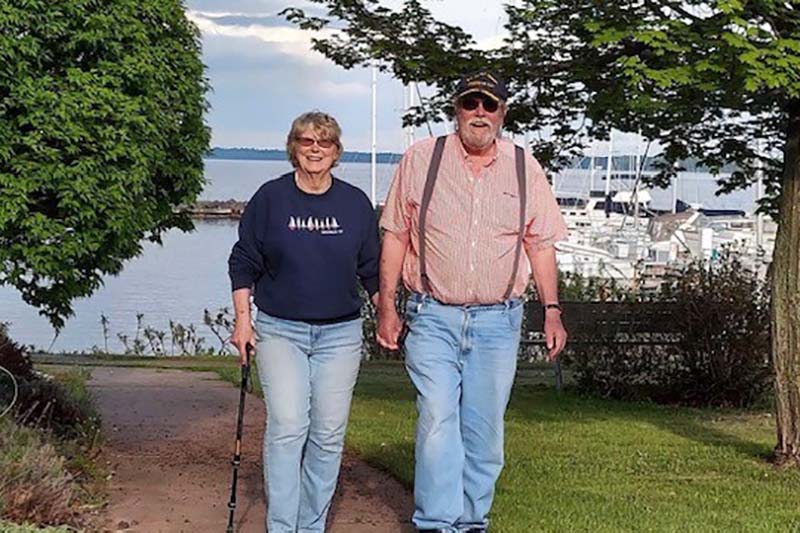Larry MacDonald is the former mayor of Bayfield, Wisconsin.
Who are you and what is your role?
I retired as mayor of Bayfield five years ago after 20 years in office. I actively serve as chair of the Wisconsin Coastal Management Council and on the Wisconsin Sea Grant Advisory Council.
What are the impacts of climate change in northern Wisconsin?
People are tremendously concerned — locals in northern Wisconsin thought they might be immune to climate change but things are changing so fast. Temperatures in Lake Superior are rising dramatically. We are going to have different kinds of fish, or no fish. There is less ice, which increases the potential for year-round water transport. People didn’t expect to see any changes and now things are changing so fast. This will cause a change in the culture, in activities like ice fishing, but also in the types of trees and vegetation.

What impacts are you seeing?
Mostly we are seeing the impacts of severe storms. Infrastructure was not built to the right size and now roads are washing out. Saxon Harbor, near Hurley in Iron County, completely washed out during a storm in 2016. They lost the campground, the marina, everything. It’s just reopening now, in 2021, so that shows how long it takes to rebuild.
Pollution and algal blooms are a problem. There was concern about a recent application for a pig farm in the area. The factory farm would have been in the Lake Superior Basin. During a flood, which is now a given, it could have sent millions of gallons of pig water into Lake Superior, right where the City of Ashland has its water intake. Not all the localities get their water from Lake Superior, some have deep-water wells. But for those who do, the water quality matters.
Bluff erosion has gotten worse with high water levels. Bayfield will end up spending $1 million on a breakwater because boulders the size of cars are being rolled around in all these large storms. Lake levels are down now but only about three inches, not enough. I worked on a United States-Canadian committee about 10 years ago, which was only focused on low water levels. In retrospect, they should have also talked about what to do when the water levels came back up really high.
How well is the community positioned to adapt?
The desire is there, but the current ability to implement change is questionable. There are funding issues at the local government level.
You also need an engaged community — city staff, county staff, and local officials — and money to make change. I see hesitancy at the state and federal level to acknowledge what’s happening and the severity of it. When I was mayor, I spoke around the state a lot on Bayfield’s sustainability initiatives. The question I constantly got, “My city council doesn’t give a darn, what do I do?” You need direction from leadership. It takes time to convince people to change their minds or be more open-minded.
Climate change means a lot of things. Many people are put off by the language. Bluff erosion is one example. About 20 years ago people were angry about setbacks from the bluff. Now, many years later, there are some houses being moved twice because they were at risk of falling in the lakes.
What advice would you give to communities that are trying to adapt?
Pay attention to the grassroots, build relationships, and talk to people. Collaborate with schools in your area. We have had very successful collaborations with Northland College. The students poured into Bayfield to help with sustainability projects. They brought a new level of energy and creative ideas. Everyone has some sort of school nearby.
Bayfield was recognized as an early adopter for climate adaptation and mitigation. Bayfield has had a Sustainability Plan since 2012. They’re still paying attention to it at the city level. I was invited once to go to Stockholm, Sweden, to represent the rural United States sustainability efforts. I told them, “A small, rural community can engage people. It keeps coming back to having the trifecta of staff, funding, and an engaged, local population.”
What is going to be important for northern Wisconsin to get ready for future climate scenarios?
Plan for extreme storms in terms of your roads, bridges, and culvert infrastructure. Engineering has been saying, “build to a 100-year flood and you’re fine,” but that’s not true anymore. Help people identify what they’ve got and what they need. At the local level, they are limited in ability to fund things.
Another problem to address is Federal Emergency Management Agency (FEMA) money disbursement and what it can be used for. When something happens to infrastructure, historically you could only use the money to fix it to the condition it was in. You can’t build better. Apparently, it has gotten a little more lenient recently but I haven’t seen that officially.
One important thing I’ve learned over the years is that the Native American idea to plan for the seventh generation is something that the rest of us should do, though we don’t. Tribes need to be recognized for that. They have a perspective of stewardship that will be helpful for all of us as the climate changes.
The views and opinions expressed in this interview are those of the authors and do not represent official policy or position of the University of Wisconsin-Madison or the Wisconsin Initiative on Climate Change Impacts.